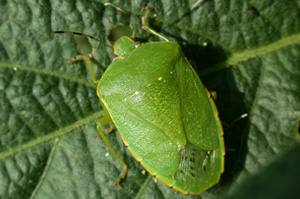The brown marmorated stink bug (BMSB) from Asia has been getting the most press in the U.S. for the last few years, but the native green stink bug has been wreaking damage on vegetable and fruit crops for decades. Green stink bugs suck plant sap from leaves, fruit buds and blossoms, causing blossoms and pods to drop prematurely, leaving spots on fruits and vegetables, deforming fruit and reducing crop yields. The tiny holes they leave behind can serve as a way for diseases to get into plants. The favorite food of adult green stink bugs are seeds, fruits, and vegetables, but they will also eat plants’ stems and foliage. They are most often found on:
- beans
- tomatoes
- corn
- eggplant
- soybeans
- okra
- squash


Green stink bugs are shield-shaped like the BMSBs, but are bright to light green in color with narrow yellow, orange or reddish edges to their bodies. They have dark red to black eyes and the three outermost segments of their antennae are black. Females lay double rows of barrel-shaped eggs that they attach to the underside of leaves. The nymphs that hatch are black at first, then turn green with the distinctive side markings. It takes about two months for a nymph to grow into an adult. A green stink bug may occasionally make its way into your home, but unlike the BMSB they prefer to spend their winters outdoors, hibernating in leaf litter, under tree bark or in a tree hole until spring.

As a Home Protection Plan customer, if you’re not satisfied with our pest control service, we will service your home at no additional cost until your issue is solved or receive your money back from your last scheduled service.

Green stink bugs cause mostly cosmetic damage to your fruits and vegetables; cut out the cloudy or deformed spots and you can still enjoy your garden produce. Green stink bugs have become more resistant to insecticides over the years. To limit their impact in your garden:
- Clean up any garden debris
- Handpick bugs off plants
- Destroy any egg masses you find.
Be careful when you’re handling green stink bugs, however; they do give off an unpleasant scent when they are frightened.


